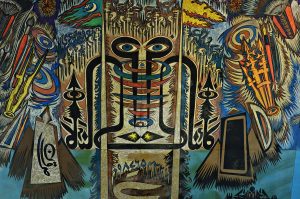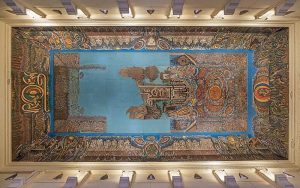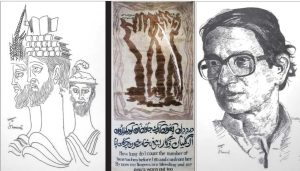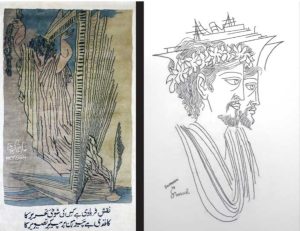Prachi Sahasrabudhe
Calligraphy, the art of beautiful writing, has fascinated humanity for millennia. Sadiquain Naqqash, a renowned Pakistani artist, was one significant individual who revitalised calligraphy. Sadiquain revolutionised calligraphic art with his unique style and inventive technique, leaving an enduring imprint on the artistic landscape. In this essay, we will look at Sadiquain Naqqash’s mesmerising calligraphic work, exploring his unique techniques, famous works, and enduring legacy.
Syed Sadiquain Ahmed Naqvi, also known as Sadiquain Naqqash was a renowned artist who descended from a family of calligraphers. He was born in Amroha, India in 1930. He came to Pakistan after the partition in 1947. He began his artistic path at an early age. Sadiquain Naqqash carved a unique path in embodying contradictory subjectivity. He maintained a character that brought transgressive Indo-Persian Sufism into dialogue with Transnational Modernism, resulting in the creation of a Modernist language known as “Calligraphic Modernism.” Pioneered by Hanif Ramay, Iqbal Geoffrey, and Anwar Jalal Shemza, Calligraphic Modernism, was a prominent modality in Pakistani art throughout the 1960s and 1970s.
Huseyn Shaheed Suhrawardy, who brought Sadiquain into the limelight noticed his genuine talent. His creative career began with traditional Persian and Arabic calligraphy, which he learned from expert calligraphers. Sadiquain also spent time in Paris honing his abilities. Sadiquain drew inspiration for his art from old manuscripts, Islamic architecture, and classical poetry, infusing it with a strong respect for Islamic culture and tradition. Sadiquain began experimenting with many styles and methods in his early years, hoping to build a distinct voice in his calligraphic work. He studied the works of great calligraphers such as Mir Ali Tabrizi and Abdul Majeed Parveen Shakir, merging their ideas with his own. He garnered widespread acclaim for his calligraphic style, which many South Asian art experts regard as a classic.
Sadiquain was widely recognised for his authentic creativity and emerging techniques in Islamic calligraphy. His international acclaim was due to the introduction of new projects and trends in art,
notably lyrical calligraphy, which was virtually non-existent at the time. His original great themes and massive murals overwhelm many, and some are still considered world-class. Sadiquain’s excellent performance in his mid-twenties projected his abilities and latent qualities. This faster awareness set the groundwork for him to express his actual inner sentiments in his artworks. Soon after, he established his own autonomous place in the world, which remained unrivalled in many respects during his lifetime and even after. He was a firm believer in reality and lyricism. He stayed far away from imaginative fairy-tale, flora and fauna themes till his final day. His portrayal of the Quran and poetry in a novice style left an indelible mark on Pakistani art. Since, the non-existent calligraphy has evolved into a culture, and this new introduction is still blooming and spreading inspiration globally, even a quarter century after his death.
Sadiquain Naqqash was noted for his ability to combine tradition and creativity, resulting in a lively and expressive style of calligraphy. He expertly combined the beauties of Persian, Arabic, and Urdu calligraphy, bringing each stroke and letter to life. Sadiquain’s development of the “Sadiquaini” style, a combination of calligraphy and painting, was one of his greatest accomplishments. He mixed poems from famous poets such as Ghalib and Iqbal with his colourful brushwork and colour pallet in this manner. His inventive techniques, vivid colour usage, and merging of numerous art forms have paved the way for new pathways of innovation in the field of calligraphy. This collaboration produced a visually spectacular exhibition of complicated lettering and powerful strokes loaded with great significance and passion. His use of larger letters and phrases, along with exquisite details, resulted in aesthetically appealing compositions. This inventive use of size and ornamentation gave the art form a new and dynamic dimension.
Sadiquain’s art was infused with Islamic culture and tradition. He emphasised the beauty of Islamic texts, poetry, and architectural aspects via his calligraphic work. Sadiquain contributed to the continued preservation and promotion of Islamic creative traditions by maintaining and reinterpreting these cultural components. Sadiquain’s calligraphic art was frequently laced with symbolism and philosophical profundity. He investigated spirituality, social justice, and human emotions, putting great significance into his calligraphy. “The Holy Verses,” one of his renowned series, demonstrates his mastery of the calligraphic form. Sadiquain’s brushwork emphasises the spiritual and mystical parts of the text in each piece in the series, representing a profound understanding of Quranic passages.
One of Naqqash’s distinguishing features was his ability to smoothly integrate ancient traditions with his own unique ways. He learned several calligraphic scripts, including Nasta’liq, Thuluth, and Kufic, and expertly mixed them to produce one-of-a-kind compositions. Naqqash’s command of these scripts enabled him to bring harmony and balance into his work while also infusing his style and aesthetic expression. The calligraphic style of Naqqash was characterized by its fluidity and rhythmic movement. His brush strokes swirled over the canvas, bringing life and passion to his lettering. His works frequently used huge letters that linked beautifully with one another, producing a compelling visual rhythm. Naqqash’s fine pen control allowed him to adjust the line thickness, resulting in a dynamic interplay of light and shade.
Sadiquain Naqqash’s prodigious body of work includes several calligraphic masterpieces. The mural he created for the ceiling of the Lahore Museum’s entrance hall is a testament to his immense talent and dedication, covering an area of approximately 9,000 square feet. The mural depicts verses from Allama Iqbal’s poetry, and Naqqash’s calligraphy weaves seamlessly into the overall composition, enhancing the grandeur and magnificence of the space. His elaborate calligraphic compositions merge Urdu and Arabic letters with abstract forms and themes in this mural. His murals generally included densely interwoven pictures and precise details that filled every available inch, which is a unique quality factor in and of itself. In production, he pointed to his pleasure and did tremendous honour to the topic – but in his own inspired way.
 The Roof of Frere Hall, Karachi, Pakistan, c. 1986. Mural by artist Sadequain Naqqash, integrating calligraphy elements into a modern artwork, https://commons.wikimedia.org/
The Roof of Frere Hall, Karachi, Pakistan, c. 1986. Mural by artist Sadequain Naqqash, integrating calligraphy elements into a modern artwork, https://commons.wikimedia.org/
Sadiquain also initiated a mural entitled ‘Arz – o-Samawat’ (Heaven and Earth) at Karachi’s Frere Hall, where he covered the dome with mesmerising calligraphic designs. This work’s gigantic magnitude demonstrates his ability to turn architectural spaces into immersive creative experiences, however, due to his death in 1987, it remained unfinished.
 The mural “Arz-o-Samawat” (Earth and the Heavens) on the ceiling of Frere Hall, Karachi bears a historical significance since it represents the last piece of work by Sadiquain. Bright colours are used to depict the earth and heaven. This mural is painted on several individual panels and is put together like the pieces of a puzzle, https://www.facebook.com/MOHKAM.ART
The mural “Arz-o-Samawat” (Earth and the Heavens) on the ceiling of Frere Hall, Karachi bears a historical significance since it represents the last piece of work by Sadiquain. Bright colours are used to depict the earth and heaven. This mural is painted on several individual panels and is put together like the pieces of a puzzle, https://www.facebook.com/MOHKAM.ART
However, Sadiquain’s calligraphy did not confine itself to religious themes. He also dabbled in sociological themes, employing calligraphy as a potent weapon for social criticism. “The Saga of Labour,” his masterwork, highlighted the condition of labourers, stressing their hardship and fortitude using calligraphic styles. Calligraphy, according to Naqqash, had the potential to elevate the written word, transforming it into a visual feast for the eyes. Apart from calligraphy, Naqqash’s work sometimes included delicate and precise miniature paintings, demonstrating his flexibility as an artist. Sadiquain was inspired by a cactus tree’s difficult living circumstances, which is mirrored in his paintings of rough and rugged human shapes that strive to portray the rigid uneven patterns of poverty. His paintings complimented his calligraphic compositions brilliantly, providing a perfect combination of aesthetic components. Naqqash’s paintings based on Omar Khayyam’s epic poem “The Rubaiyat of Omar Khayyam” exhibit his talent for merging poetry, calligraphy, and visual art.
Sadiquain’s rise to fame in Pakistan began in 1955 when he exhibited his works at Prime Minister Huseyn Shaheed Suhrawardy’s residence. He soon received prestigious government mural commissions and held numerous solo exhibitions of his work. His work drew freely from Transnational Modernism, with the figure of Picasso playing a central role. Naqqash has been awarded various awards and honours for his contributions to the fields of art and calligraphy. These include the “Tamgha-e-Imtiaz” by the Government of Pakistan (1960), the “Biennale de Paris” award by the Government of France (1962), the “President Medal of Honour” by President of Pakistan (1962), the “Cultural Award” by Government of Australia (1975) and the “Sitara-e-Imtiaz” by Government of Pakistan (1980). His calligraphic works have been displayed in major galleries and museums worldwide, and he received the renowned Sitara-e-Imtiaz, one of Pakistan’s highest civic prizes. His international acclaim has helped to raise the prominence of Islamic art and calligraphy as a recognised and admired art form on a global scale.
Sadiquain’s approach towards calligraphy was primitive and energetic, and he was successful in broadening his audience. Until his death, he painted murals at prestigious public places, declaring that his art was for “the people.” Sadiquain’s goal of enabling as many people as possible to view his paintings by shifting from gallery representation to state patronage allowed him to reach a broader audience, and his public interventions were more conservative. Sadiquain Naqqash’s calligraphic work has left an indelible mark on Islamic art and calligraphy. His legacy continues to inspire young calligraphers as well as art enthusiasts today. Sadiquain has enriched the creative environment and encouraged generations of artists to push the frontiers of calligraphic expression via his blending of tradition and contemporary, reinvention of artistic language, preservation of cultural legacy, and worldwide acclaim. Naqqash’s work exemplifies the everlasting power of calligraphy and its ability to cross-cultural barriers. His efforts continue to define and impact the world of Islamic art and calligraphy as it evolves.
***
References:
Dadi Iftikhar, “Modernism and the Art of Muslim South Asia”, Sadiquain and Calligraphic Modernism, Chapter 3, pp 134 to 176.
Rubab Fatima, “Tribute to Sadiquain’s Legacy,”29 Feb – 06 Mar 2020, MAG the Weekly, https://magtheweekly.com/detail/8241-tribute-to-sadequains-legacy
https://prideofpakistan.com/famedetail.php?name=SadequainAhmedNaqvi&id=595








